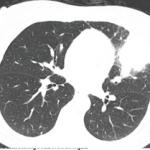One of the most intellectually satisfying aspects of our specialty is how, just by using our eyes and our minds, we can often spot precious clinical pearls that may instantly define a diagnosis.
Cancer & Autoimmunity: Is there a link?
Of course, no hand exam would be complete without a search for Gottron’s papules, those violaceous lesions with a predilection for the knuckles that identify dermatomyositis and its attendant risk for malignancy. Dermatomyositis can be a challenging disease to manage, especially when it’s refractory to treatment. Is the disease under the spell of an occult malignancy that is driving an aberrant immune response? This tantalizing concept has been raised countless times in the past, but until recently there was little scientific evidence to support it. However, a recent landmark study, albeit in another disease, may shed some light on the link between cancer and autoimmunity.
Researchers at the Johns Hopkins University in Baltimore took advantage of the clinical observation that a subset of patients with scleroderma who produce autoantibodies to RNA polymerase-1 (RPC1) are highly susceptible to developing cancer.7 They examined tumor tissue and blood samples from 16 scleroderma patients with various types of cancer. Among the eight patients who had anti-RPC1 autoantibodies and coincident cancer, six had genetic mutations—either somatic mutations or loss of heterozygosity (only one copy of an allele) in POLR3A (polymerase III polypeptide A, the gene encoding RPC1). The other eight patients had autoantibodies to the two other antigens commonly associated with scleroderma, either topoisomerase 1 (anti-TOP1) or centromere protein B (anti-CENPB), and all developed delayed cancer. Interestingly, all the anti-RPC1 antibodies recognized both wild-type and mutated RPC1, indicating that the humoral immune response did not directly target the area of the mutation or discriminate between mutant and wild-type versions of RPC1. But some patients with scleroderma who possessed defined POLR3A mutations had T cells that reacted to RPC1 protein fragments produced from the mutated gene. The reactivity was specific to the patient and peptide, but the frequencies of these T cells were comparable to those observed in other autoimmune diseases. Given that POLR3A mutations are exceedingly rare in cancer (0.7% overall), it seemed likely to the authors that the onset of scleroderma and the cancer genomes of these patients were related and that the mutations and T cell responses directed against them were not coincidental. Although just a handful of patients was studied, the findings suggest that a genetic mutation in some cancers can trigger a patient’s concurrent autoimmune disorder, scleroderma.8 Voilà! Perhaps these insights can be extrapolated to dermatomyositis as well.


